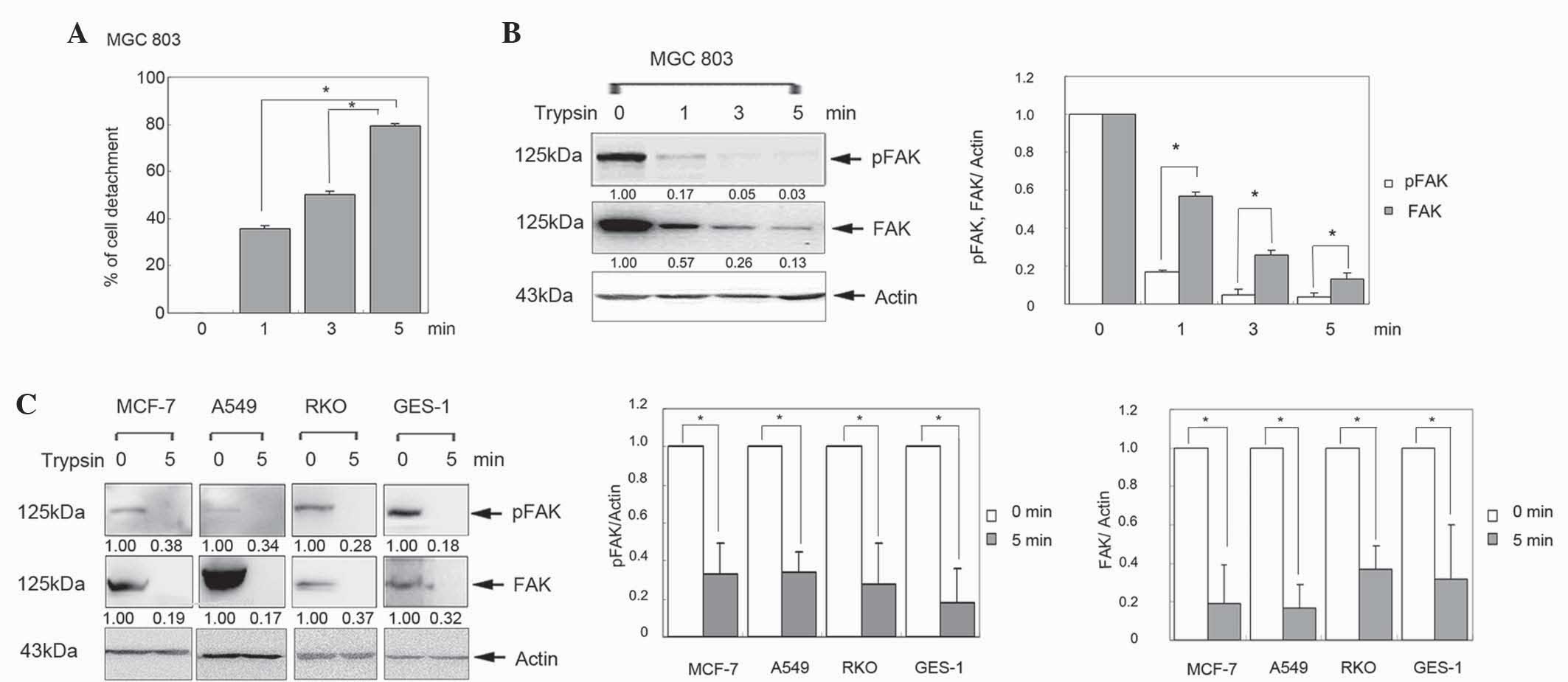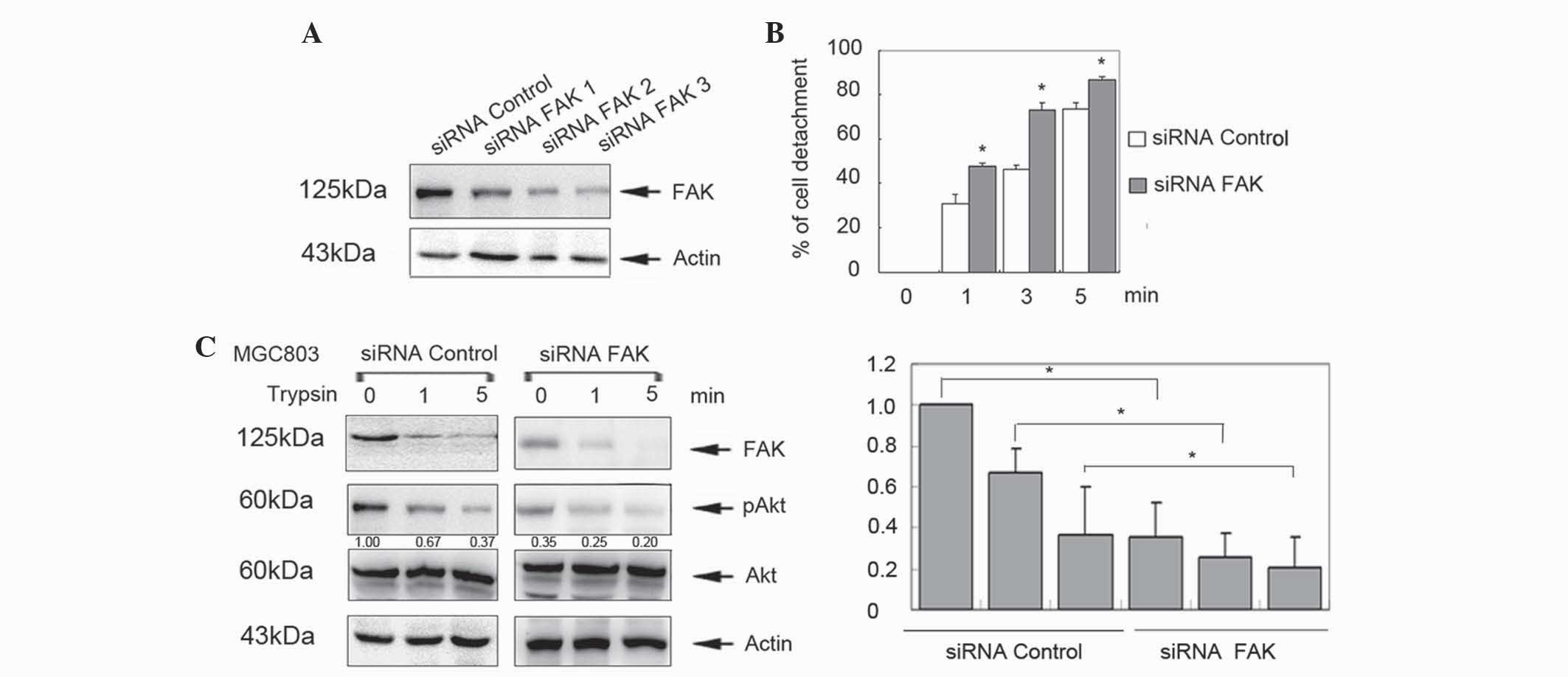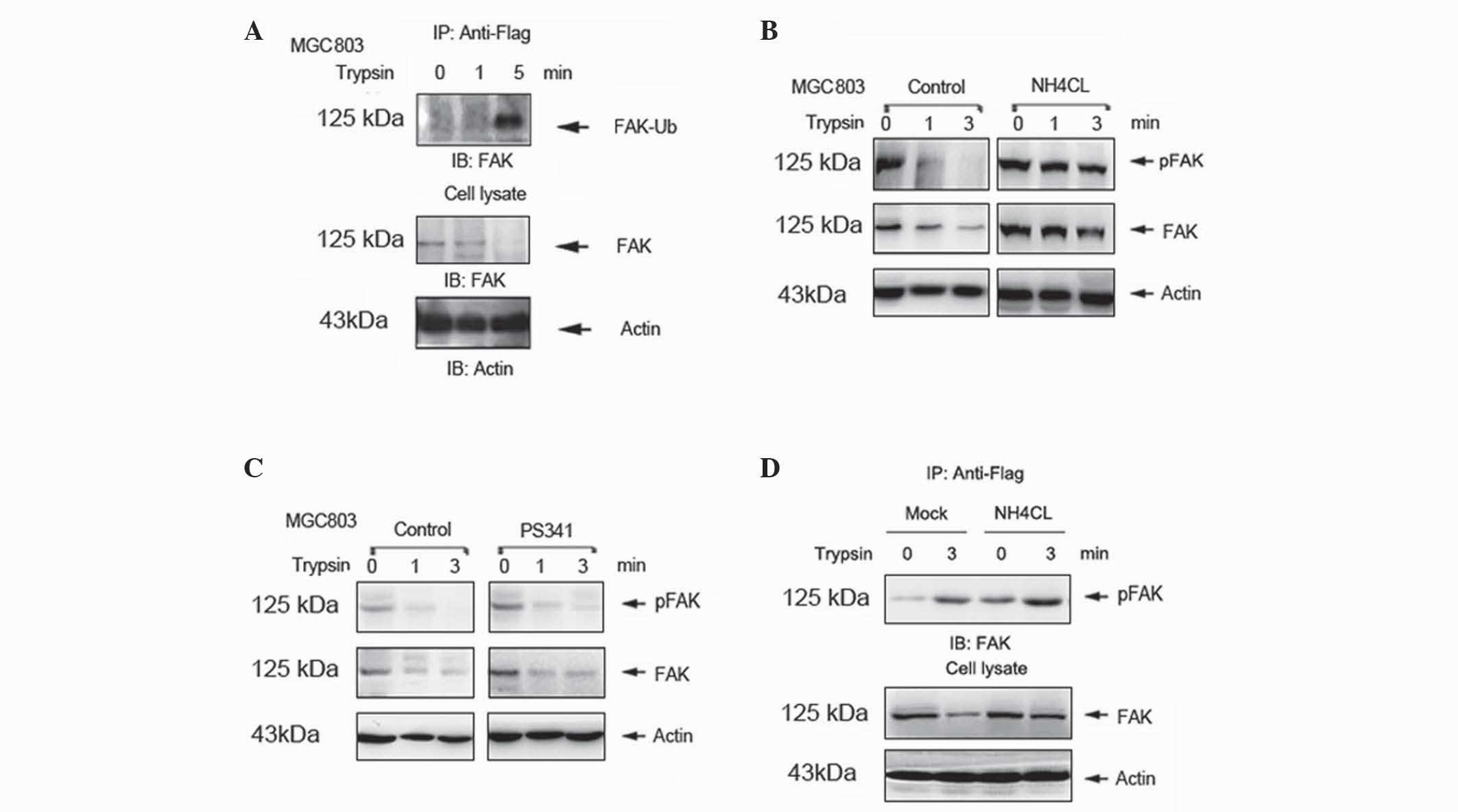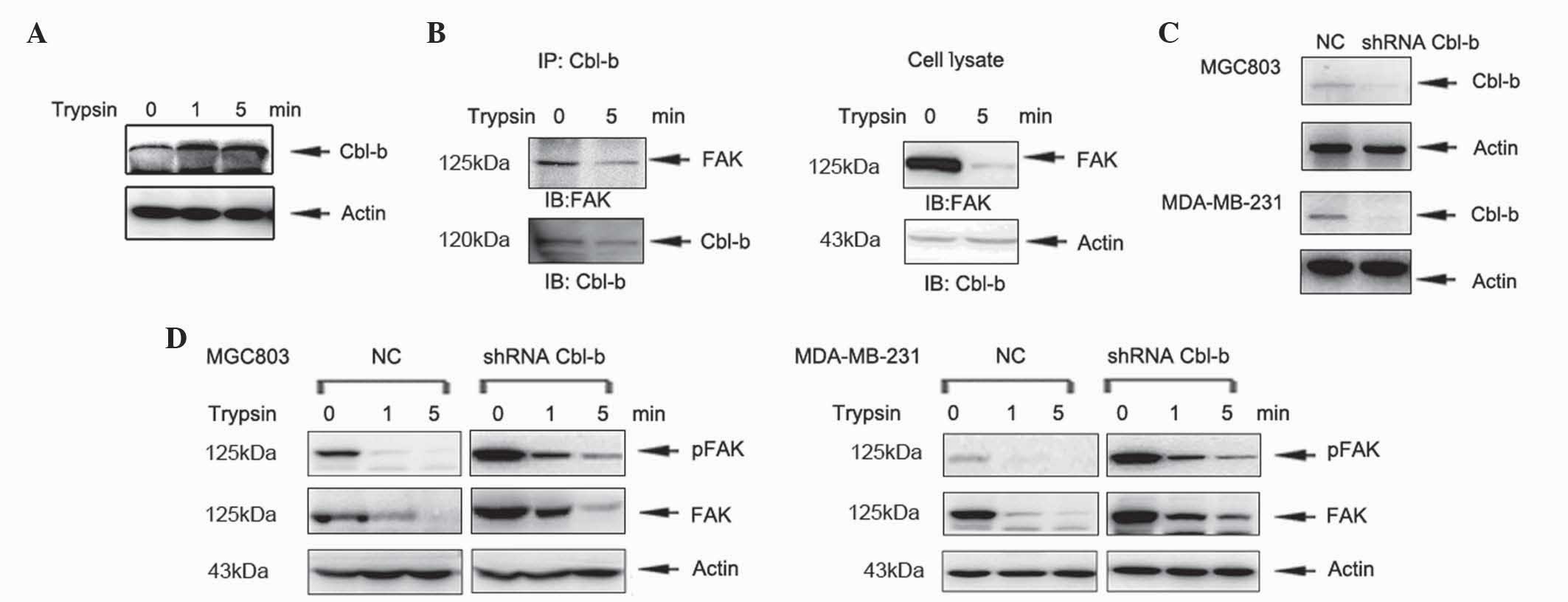Cbl‑b promotes cell detachment via ubiquitination of focal adhesion kinase
- Authors:
- Published online on: June 15, 2016 https://doi.org/10.3892/ol.2016.4730
- Pages: 1113-1118
Abstract
Introduction
The first step of tumor metastasis is cell detachment from a primary tumor (1). Normally, adhesions between normal epithelial cells and the cellular matrix are strong; cell detachment may be achieved via downregulation of cell adhesion molecules (2). It has been reported that loss of E-cadherin results in the detachment of adjacent cells (3,4). Focal adhesion kinase (FAK) is a central regulator of focal adhesion, promoting cell adhesion and metastasis (5). Previous studies have reported that simultaneous inhibition of FAK promotes the detachment of colon cancer cells and fibroblasts (6,7). However, Wade et al (8) reported that FAK tyrosine phosphorylation was present in detached fibroblast cells. Therefore, the involvement of FAK in cell detachment remains controversial.
Casitas B-lineage lymphoma-b (Cbl-b), a RING finger E3 ubiquitin protein ligase, is composed of a tyrosine kinase binding domain, an ubiquitin-associated domain, RING finger domains and several tyrosine phosphorylation sites. It has been hypothesized that Cbl-b exhibits a crucial function as a ubiquitin ligase and multifunctional adaptor molecule (9). A previous study demonstrated that Cbl-b is involved in the regulation of the cell cytoskeleton and adhesion (10). Furthermore, it has been reported that Cbl-b reduces cell adhesion via negative regulation of integrin and receptor-mediated signaling (11). By contrast, a previous study reported that Cbl-b enhances cell-to-cell adherens junctions and cell adhesion (12). Schmidt and Dikic (13) revealed that c-Cbl, a homolog of Cbl-b, associates with FAK and affects cellular attachment to the extracellular matrix (ECM). In addition, Rafiq et al (14) demonstrated that c-Cbl interacts with FAK, resulting in enhanced c-Cbl-mediated FAK ubiquitination and subsequent downregulation of myocyte survival signaling. However, whether Cbl-b targets FAK for degradation and its involvement in the process of cell detachment requires further investigation.
The aim of the present study was to evaluate the effect of FAK and its function in the process of tumor cell detachment. The present study demonstrated that FAK suppressed trypsin-induced cell detachment, and lysosome inhibitor NH4Cl suppressed cell detachment through mono-ubiquitination of FAK, while Cbl-b promoted cell detachment through ubiquitination of FAK. These results provide novel insights into the role of Cbl-b and FAK in cell detachment.
Materials and methods
Reagents and antibodies
Antibodies against Cbl-b (mouse monoclonal catalog no., sc-8006; dilution, 1:250) and actin (rabbit polyclonal; catalog no., H-196; dilution, 1:1,000) were purchased from Santa Cruz Biotechnology, Inc. (Dallas, TX, USA). Antibodies against Akt (rabbit polyclonal; catalog no., 4691; dilution, 1:1,000), phosphorylated (p)-Akt (rabbit polyclonal; catalog no., 4060; dilution, 1:500), FAK (rabbit polyclonal; catalog no., 3285; dilution, 1:500), anti-p-FAK (rabbit polyclonal; catalog no., 8556; dilution, 1:500) and ubiquitin (rabbit polyclonal; catalog no., 3936; dilution, 1:500) were obtained from Cell Signaling Technology, Inc. (Danvers, MA, USA). Dimethyl sulfoxide was obtained from Sigma-Aldrich (St. Louis, MO, USA).
Cell culture
The human gastric adenocarcinoma MGC803, lung adenocarcinoma A549, colon carcinoma RKO, breast adenocarcinoma MCF-7, breast carcinoma MDA-MB-231 and gastric epithelial cell GES-1 cell lines were obtained from the Academy of Military Medical Sciences (Beijing, China). The cells were cultured in RPMI-1640 medium or L-15 medium containing 10% fetal calf serum (all Gibco®; Thermo Fisher Scientific, Inc., Waltham, MA, USA) at 37°C in a humidified incubator with an atmosphere of 5% CO2.
MTT assay
The percentage of detached cells was analyzed using MTT assay. The cells (2×105 cells/well) were treated with 2.5 mg/l trypsin for various times (0, 1, 3 and 5 min) and washed four times with ice-cold phosphate-buffered saline. The MTT assay was performed as described in a previous study by the present authors (15).
Western blot analysis
The cells (2×105 cells/well) were seeded in 6-well plates and incubated overnight. The cells were treated with 2.5 mg/l trypsin for various times (0, 1, 3 and 5 min). The medium was removed and the cells were added to a 1.5 ml Eppendorf tube followed by transient centrifugalization. Western blot analysis was performed as described in a previous study (15). Western blot images were analyzed using National Institutes of Health image software (rsb.info.nih.gov/nih-image/) for further statistical analysis.
Immunoprecipitation
The antibodies against FAK and Cbl-b, protein G-agarose beads (Cell Signaling Technology, Inc.) and cell lysate were incubated overnight at 4°C. Subsequently, immunoprecipitates were washed four times with lysis buffer. Immunoprecipitation was performed as described in a previous study (16).
Plasmid construction and transfection
Plasmid construction was performed as described in a previous study (15). Briefly, MGC803 and MDA-MB-231 cells were transfected with short hairpin (sh) RNA targeting Cbl-b using Lipofectamine 2000 reagent (Invitrogen™; Thermo Fisher Scientific, Inc), according to the manufacturer's protocol. One set of synthetic oligonucleotides involved the sense and antisense target sequences of human Cbl-b: Sense, 5′-GGATCCCGGATGTGTTTGGGACTAATTTGATATCCGATTAGTCCCAAACACATCCTTTTTTCCAAAAGCTT-3′ and antisense, 5′-AAGCTTTTGGAAAAAAGGATGTGTTTGGGACTAATCGGATATCAAATTAGTCCCAAACACATCCGGGATCC-3′ were annealed and ligated into the BamHI/HindIII-cleaved backbone of pRNA-U6.1/Neo (Genescript, Piscataway, NJ, USA). Stably transfected cell lines were selected according to the methods described in a previous study (17). The cDNA of Flag-tagged ubiquitin (Flag-Ub) was provided by Dr Kiyonao Sada (Division of Genome Science and Microbiology, University of Fukui, Fukui, Japan). All cDNAs were then subcloned into the pSVL expression vector (GE Healthcare, Piscataway, NJ, USA). MGC803/NC and MGC803/shCbl-b, MDA-MB-231/NC and MDA-MB-231/shCbl-b cells transfected with shRNA-Cbl-b were used for the following experiments.
Small interfering (si)RNA transfections
FAK siRNA was obtained from Shanghai GeneChem Co. Ltd., (Shanghai, China). MGC803 cells were transfected with siRNAs using Lipofectamine 2000, according to the manufacturer's protocol. FAK siRNA sequences were synthesized as follows: FAK siRNA sequences were synthesized as follows: siFAK-1, CAGGUGAAGAGCGAUUAU Att; siFAK-2, CUCCAGUCUACAGAUUUGAtt; siFAK-3, CCCAGGUUUACUGAACUUAtt. After 48 h of transient transfection, the cells were analyzed by western blotting to determine the effect of FAK siRNA on FAK expression.
Statistical analysis
All experiments were performed in triplicate. Data were expressed as the mean ± standard deviation. Statistical significance was determined using the Student's t-test. Statistical analysis was performed using SPSS version 18.0 software (SPSS, Inc., Chicago, IL, USA). P<0.05 was considered to indicate a statistically significant difference.
Results
Decreased FAK expression is associated with trypsin-induced cell detachment
To investigate the effect of FAK in cell detachment, the human gastric cancer MGC803 cell line was treated with trypsin for 0, 1, 3 and 5 min. The percentage of detached cells was significantly increased in a time-dependent manner (Fig. 1A; P<0.05). Furthermore, western blot analysis revealed that FAK was gradually reduced in a time-dependent manner (Fig. 1B). Similar results were observed in human breast cancer MCF-7, lung cancer A549, colon cancer RKO and gastric epithelial GES-1 cells (Fig. 1C; P<0.05). These results indicate that FAK is downregulated in the process of cell detachment.
FAK inhibits trypsin-induced cell detachment
To further clarify the function of FAK in the process of cell detachment, MGC803 cells were transfected with FAK-specific siRNAs for 48 h. Knockdown of FAK expression was detected by western blotting (Fig. 2A). siRNA 3 was selected for further analysis, which revealed that knockdown of FAK significantly increased cell detachment compared with controls in a time-dependent manner (P<0.05; Fig. 2B). In addition, p-Akt levels were decreased in the siRNA/FAK group (Fig. 2C). These data indicate that FAK inhibits cell detachment in cancer cells and human gastric epithelial cells.
Ubiquitin-lysosome degradation mediates trypsin-induced degradation of FAK
A previous study demonstrated that ubiquitin-dependent protein degradation is critical in the regulation of FAK (14). However, whether ubiquitination degradation mediates trypsin-induced degradation of FAK is currently unknown. In the present study, MGC803 cells were transfected with plasmids expressing Flag-Ub. Mono-ubiquitination of FAK was increased in a time-dependent manner following trypsin treatment of the transfected cells (Fig. 3A). In the NH4Cl-pretreated group, FAK degradation was suppressed compared with the control (Fig. 3B). However, similar results were not observed in cells pretreated with the proteasome inhibitor PS-341 (Fig. 3C). To further investigate whether the degradation of FAK occurs via the ubiquitin-lysosome system, MGC803 cells were transfected with plasmid expressing Flag-Ub for 48 h, in the absence or presence of 50 nM NH4Cl for 12 h. Mono-ubiquitination of FAK was enhanced in the NH4Cl pretreated group (Fig. 3D). These results indicate that the ubiquitin-lysosome system mediates trypsin-induced degradation of FAK.
Cbl-b accelerates trypsin-induced cell detachment
A previous study demonstrated that the E3 ubiquitin protein ligase c-Cbl is involved in the ubiquitination of FAK (14). Therefore, the involvement of Cbl-b in ubiquitination and degradation of FAK requires further investigation. In the present study, MGC803 cells were treated with trypsin for 1 and 5 min and the level of Cbl-b protein was analyzed. The expression of Cbl-b increased in a time-dependent manner (Fig. 4A). Furthermore, Cbl-b interacted with FAK in the absence and presence of trypsin treatment, as demonstrated by co-immunoprecipitation (Fig. 4B). In order to further investigate the function of Cbl-b in cell detachment, previously established shRNA plasmids targeting Cbl-b, which were stably transfected into MGC803 cells (16), were used for further experiments. The shRNA plasmids targeting Cbl-b were also stably transfected into MDA-MB-231 cells and Cbl-b expression was evaluated by western blotting (Fig. 4C). Knockdown of Cbl-b increased the expression of FAK (Fig. 4D). These results indicate that Cbl-b accelerates trypsin-induced cell detachment via degradation of FAK.
Discussion
It has been reported that FAK not only promotes cell adhesion, but is also involved in cell detachment (6–8,17). Kim et al (18) reported that okadaic acid induces cell detachment, which is accompanied by FAK dephosphorylation. Zouq et al (7) reported that fibroblasts and epithelial cells exhibit rapid dephosphorylation of FAK in response to detachment from the ECM. Conversely, overexpression of the FAK N-terminus induces rounding, detachment and apoptosis in breast carcinoma cells (17). Thus, the effect of FAK in cell detachment remains controversial. In the present study, expression and phosphorylation of FAK were decreased following trypsin-induced detachment in cancer cell lines. Knockdown of FAK further enhanced trypsin-induced cell detachment. These data indicate that FAK inhibits trypsin-induced cell detachment.
The ubiquitin-dependent protein degradation pathway is important for the regulation of FAK (14,19). A previous study has demonstrated that Cat.G, a neutrophil-derived serine protease, induces ubiquitin-proteasome-dependent degradation of FAK (14). Inhibition of proteasome activity markedly attenuates FAK degradation in T-, myofibril and ovarian carcinoma cells (14,20,21). In the present study, trypsin induced the mono-ubiquitination of FAK in a time-dependent manner. Additionally, the downregulation of FAK was suppressed by pretreatment with the lysosome inhibitor NH4Cl. However, similar results were not observed following pretreatment with the proteasome inhibitor PS-341. Furthermore, ubiquitination of FAK was increased in cells pretreated with NH4Cl. These results indicate that the ubiquitin-lysosome system mediates trypsin-induced degradation of FAK.
Results from previous studies have revealed that MG53, an E3 ubiquitin ligase, mediates FAK ubiquitination during skeletal myogenesis (21), and that c-Cbl is involved in FAK degradation thereby suppressing cell adhesion and myocyte survival (14). Cbl-b, a negative regulator of non-receptor tyrosine kinases, may cause FAK ubiquitination and degradation. In the present study, Cbl-b interacted with FAK in the absence and presence of trypsin. Knockdown of Cbl-b increased FAK expression and decreased trypsin-induced degradation of FAK. These findings further indicate that Cbl-b accelerates cell detachment via mono-ubiquitination of FAK.
In conclusion, the results of the present study indicate that cell detachment is mediated via ubiquitin-lysosome degradation of FAK. Furthermore, the E3 ubiquitin ligase Cbl-b contributes to cell detachment by facilitating FAK degradation. These findings provide novel insights with regard to the functions of Cbl-b and FAK in the process of cell detachment.
Acknowledgements
This study was supported by the Chinese National Foundation of National Sciences (grant nos. 81172369, 81302128, 81472193 and 81372547), the General Project of Liaoning Province Department of Education (grant no. L2014296), the National Science and Technology Major Project (grant no. 2013ZX09303002) and the Science and Technology Plan Project of Liaoning Province (grant no. 2014225013).
References
|
Finger EC and Giaccia AJ: Hypoxia, inflammation, and the tumor microenvironment in metastatic disease. Cancer Metastasis Rev. 29:285–293. 2010. View Article : Google Scholar : PubMed/NCBI | |
|
Paschos KA, Canovas D and Bird NC: The role of cell adhesion molecules in the progression of colorectal cancer and the development of liver metastasis. Cell Signal. 21:665–674. 2009. View Article : Google Scholar : PubMed/NCBI | |
|
Hwang S, Gwon SY, Kim MS, Lee S and Rhee KJ: Bacteroides fragilis toxin induces IL-8 secretion in HT29/C1 cells through disruption of E-cadherin junctions. Immune Netw. 13:213–217. 2013. View Article : Google Scholar : PubMed/NCBI | |
|
Chang M, Alsaigh T, Kistler EB and Schmid-Schönbein GW: Breakdown of mucin as barrier to digestive enzymes in the ischemic rat small intestine. PLoS One. 7:e400872012. View Article : Google Scholar : PubMed/NCBI | |
|
Wei L, Yang Y, Zhang X and Yu Q: Altered regulation of Src upon cell detachment protects human lung adenocarcinoma cells from anoikis. Oncogene. 23:9052–9061. 2004. View Article : Google Scholar : PubMed/NCBI | |
|
Golubovskaya VM, Gross S, Kaur AS, Wilson RI, Xu LH, Yang XH and Cance WG: Simultaneous inhibition of focal adhesion kinase and SRC enhances detachment and apoptosis in colon cancer cell lines. Mol Cancer Res. 1:755–764. 2003.PubMed/NCBI | |
|
Zouq NK, Keeble JA, Lindsay J, Valentijn AJ, Zhang L, Mills D, Turner CE, Streuli CH and Gilmore AP: FAK engages multiple pathways to maintain survival of fibroblasts and epithelia: Differential roles for paxillin and p130Cas. J Cell Sci. 122:357–367. 2009. View Article : Google Scholar : PubMed/NCBI | |
|
Wade R, Brimer N, Lyons C and Vande Pol S: Paxillin enables attachment-independent tyrosine phosphorylation of focal adhesion kinase and transformation by RAS. J Biol Chem. 286:37932–37944. 2011. View Article : Google Scholar : PubMed/NCBI | |
|
Zhang G, Liu J, Zhang Y, Qu J, Xu L, Zheng H, Liu Y and Qu X: Cbl-b-dependent degradation of FLIP (L) is involved in ATO-induced autophagy in leukemic K562 and gastric cancer cells. FEBS Lett. 586:3104–3110. 2012. View Article : Google Scholar : PubMed/NCBI | |
|
Duan L, Raja SM, Chen G, Virmani S, Williams SH, Clubb RJ, Mukhopadhyay C, Rainey MA, Ying G, Dimri M, et al: Negative regulation of EGFR-Vav2 signaling axis by Cbl ubiquitin ligase controls EGF receptor-mediated epithelial cell adherens junction dynamics and cell migration. J Biol Chem. 286:620–633. 2011. View Article : Google Scholar : PubMed/NCBI | |
|
Scharner D, Rössig L, Carmona G, Chavakis E, Urbich C, Fischer A, Kang TB, Wallach D, Chiang YJ, Deribe YL, et al: Caspase-8 is involved in neovascularization-promoting progenitor cell functions. Arterioscler Thromb Vasc Biol. 29:571–578. 2009. View Article : Google Scholar : PubMed/NCBI | |
|
Qu X, Liu Y, Ma Y, Zhang Y, Li Y and Hou K: Up-regulation of the Cbl family of ubiquitin ligases is involved in ATRA and bufalin-induced cell adhesion but not cell differentiation. Biochem Biophys Res Commun. 367:183–189. 2008. View Article : Google Scholar : PubMed/NCBI | |
|
Schmidt MH and Dikic I: The Cbl interactome and its functions. Nat Rev Mol Cell Biol. 6:907–918. 2005. View Article : Google Scholar : PubMed/NCBI | |
|
Rafiq K, Guo J, Vlasenko L, Guo X, Kolpakov MA, Sanjay A, Houser SR and Sabri A: C-Cbl ubiquitin ligase regulates focal adhesion protein turnover and myofibril degeneration induced by neutrophil protease cathepsin G. J Biol Chem. 287:5327–5339. 2012. View Article : Google Scholar : PubMed/NCBI | |
|
Qu X, Zhang Y, Li Y, Hu X, Xu Y, Xu L, Hou K, Sada K and Liu Y: Ubiquitin ligase Cbl-b sensitizes leukemia and gastric cancer cells to anthracyclines by activating the mitochondrial pathway and modulating Akt and ERK survival signals. FEBS Lett. 583:2255–2262. 2009. View Article : Google Scholar : PubMed/NCBI | |
|
Xu L, Zhang Y, Liu J, Qu J, Hu X, Zhang F, Zheng H, Qu X and Liu Y: TRAIL-activated EGFR by Cbl-b-regulated EGFR redistribution in lipid rafts antagonises TRAIL-induced apoptosis in gastric cancer cells. Eur J Cancer. 48:3288–3299. 2012. View Article : Google Scholar : PubMed/NCBI | |
|
Beviglia L, Golubovskaya V, Xu L, Yang X, Craven RJ and Cance WG: Focal adhesion kinase N-terminus in breast carcinoma cells induces rounding, detachment and apoptosis. Biochem J. 373:201–210. 2003. View Article : Google Scholar : PubMed/NCBI | |
|
Kim B, van Golen CM and Feldman EL: Degradation and dephosphorylation of focal adhesion kinase during okadaic acid-induced apoptosis in human neuroblastoma cells. Neoplasia. 5:405–416. 2003. View Article : Google Scholar : PubMed/NCBI | |
|
Sekine Y, Tsuji S, Ikeda O, Sugiyma K, Oritani K, Shimoda K, Muromoto R, Ohbayashi N, Yoshimura A and Matsuda T: Signal-transducing adaptor protein-2 regulates integrin-mediated T cell adhesion through protein degradation of focal adhesion kinase. J Immunol. 179:2397–2407. 2007. View Article : Google Scholar : PubMed/NCBI | |
|
Selvendiran K, Ahmed S, Dayton A, Ravi Y, Kuppusamy ML, Bratasz A, Rivera BK, Kálai T, Hideg K and Kuppusamy P: HO-3867, a synthetic compound, inhibits the migration and invasion of ovarian carcinoma cells through downregulation of fatty acid synthase and focal adhesion kinase. Mol Cancer Res. 8:1188–1197. 2010. View Article : Google Scholar : PubMed/NCBI | |
|
Nguyen N, Yi JS, Park H, Lee JS and Ko YG: Mitsugumin 53 (MG53) ligase ubiquitinates focal adhesion kinase during skeletal myogenesis. J Biol Chem. 289:3209–3216. 2014. View Article : Google Scholar : PubMed/NCBI |













